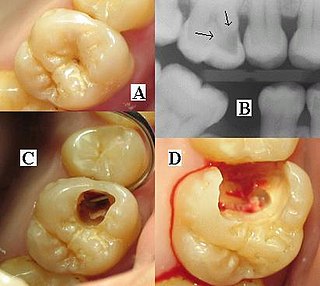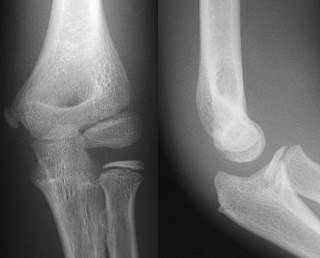
The buccal object/SLOB rule is a method used to determine the relative position of two objects in the oral cavity using projectional dental radiography.

The buccal object/SLOB rule is a method used to determine the relative position of two objects in the oral cavity using projectional dental radiography.
In 1909, Clark described a radiographic procedure for localizing impacted teeth to determining their relative antero-posterior position. [1] If the two teeth (or, by extension, any two objects, such as a tooth and a foreign object) are located in front of one another relative to the x-ray beam, they will appear superimposed on one another on a dental radiograph, but it will be impossible to know which one is in front of the other. To determine which is in front and which is behind, Clark proposed his SLOB rule , as a complicated set of three radiographs, but which can be simplified as follows using just two:
The video below shows a 5 minute illustration describing SLOB rule in dentistry

In 1952, Richards amended this rule using only 2 radiographs, [2] [3] asserting that the object positioned more buccally will move more relative to the object positioned more palatally or lingually.
As a generalization, but not specifically stated as part of Richards' buccal object rule, the more buccal an object is (i.e. the closer it is to the x-ray source) the more it will move in the second radiograph when repositioning the x-ray source.
At the University of Alabama School of Dentistry, this rule is referred to as the BAMA rule: buccal always moves away.

Hyperdontia is the condition of having supernumerary teeth, or teeth that appear in addition to the regular number of teeth. They can appear in any area of the dental arch and can affect any dental organ. The opposite of hyperdontia is hypodontia, where there is a congenital lack of teeth, which is a condition seen more commonly than hyperdontia. The scientific definition of hyperdontia is "any tooth or odontogenic structure that is formed from tooth germ in excess of usual number for any given region of the dental arch." The additional teeth, which may be few or many, can occur on any place in the dental arch. Their arrangement may be symmetrical or non-symmetrical.
Oral medicine is a specialty focused on the mouth and nearby structures. It lies at the interface between medicine and dentistry.

Veterinary dentistry is the field of dentistry applied to the care of animals. It is the art and science of prevention, diagnosis, and treatment of conditions, diseases, and disorders of the oral cavity, the maxillofacial region, and its associated structures as it relates to animals.

Dentigerous cyst, also known as follicular cyst is an epithelial-lined developmental cyst formed by accumulation of fluid between the reduced enamel epithelium and crown of an unerupted tooth. It is formed when there is an alteration in the reduced enamel epithelium and encloses the crown of an unerupted tooth at the cemento-enamel junction. Fluid is accumulated between reduced enamel epithelium and the crown of an unerupted tooth. Dentigerous cyst is the second most common form of benign developmental odontogenic cysts.

Industrial radiography is a method of non-destructive testing where many types of manufactured components can be examined to verify the internal structure and integrity of the specimen. Industrial Radiography can be performed utilizing either X-rays or gamma rays. Both are forms of electromagnetic radiation. The difference between various forms of electromagnetic energy is related to the wavelength. X and gamma rays have the shortest wavelength and this property leads to the ability to penetrate, travel through, and exit various materials such as carbon steel and other metals.

Dental anatomy is a field of anatomy dedicated to the study of human tooth structures. The development, appearance, and classification of teeth fall within its purview. Tooth formation begins before birth, and the teeth's eventual morphology is dictated during this time. Dental anatomy is also a taxonomical science: it is concerned with the naming of teeth and the structures of which they are made, this information serving a practical purpose in dental treatment.

Dental radiographs are commonly called X-rays. Dentists use radiographs for many reasons: to find hidden dental structures, malignant or benign masses, bone loss, and cavities.
This is a list of definitions of commonly used terms of location and direction in dentistry. This set of terms provides orientation within the oral cavity, much as anatomical terms of location provide orientation throughout the body.

Projectional radiography, also known as conventional radiography, is a form of radiography and medical imaging that produces two-dimensional images by x-ray radiation. The image acquisition is generally performed by radiographers, and the images are often examined by radiologists. Both the procedure and any resultant images are often simply called "X-ray". Plain radiography generally refers to projectional radiography. Plain radiography can also refer to radiography without a radiocontrast agent or radiography that generates single static images, as contrasted to fluoroscopy, which are technically also projectional.

Dental trauma refers to trauma (injury) to the teeth and/or periodontium, and nearby soft tissues such as the lips, tongue, etc. The study of dental trauma is called dental traumatology.

A panoramic radiograph is a panoramic scanning dental X-ray of the upper and lower jaw. It shows a two-dimensional view of a half-circle from ear to ear. Panoramic radiography is a form of focal plane tomography; thus, images of multiple planes are taken to make up the composite panoramic image, where the maxilla and mandible are in the focal trough and the structures that are superficial and deep to the trough are blurred.
Cone beam computed tomography is a medical imaging technique consisting of X-ray computed tomography where the X-rays are divergent, forming a cone.

Tooth wear refers to loss of tooth substance by means other than dental caries. Tooth wear is a very common condition that occurs in approximately 97% of the population. This is a normal physiological process occurring throughout life; but with increasing lifespan of individuals and increasing retention of teeth for life, the incidence of non-carious tooth surface loss has also shown a rise. Tooth wear varies substantially between people and groups, with extreme attrition and enamel fractures common in archaeological samples, and erosion more common today.

Tricho-dento-osseous syndrome (TDO) is a rare, systemic, autosomal dominant genetic disorder that causes defects in hair, teeth, and bones respectively. This disease is present at birth. TDO has been shown to occur in areas of close geographic proximity and within families; most recent documented cases are in Virginia, Tennessee, and North Carolina. The cause of this disease is a mutation in the DLX3 gene, which controls hair follicle differentiation and induction of bone formation. One-hundred percent of patients with TDO suffer from two co-existing conditions called enamel hypoplasia and taurodontism in which the abnormal growth patterns of the teeth result in severe external and internal defects. The hair defects are characterized as being rough, course, with profuse shedding. Hair is curly and kinky at infancy but later straightens. Dental defects are characterized by dark-yellow/brownish colored teeth, thin and/or possibly pitted enamel, that is malformed. The teeth can also look normal in color, but also have a physical impression of extreme fragility and thinness in appearance. Additionally, severe underbites where the top and bottom teeth fail to correctly align may be present; it is common for the affected individual to have a larger, more pronounced lower jaw and longer bones. The physical deformities that TDO causes become more noticeable with age, and emotional support for the family as well as the affected individual is frequently recommended. Adequate treatment for TDO is a team based approach, mostly involving physical therapists, dentists, and oromaxillofacial surgeons. Genetic counseling is also recommended.

Amalgam tattoo is a grey, blue or black area of discoloration on the mucous membranes of the mouth, typically on the gums of the lower jaw. It is a healthcare caused lesion, due to entry of dental amalgam into the soft tissues. It is common, painless, and benign, but it can be mistaken for melanoma.
Albert G. Richards (1917-2008) was a photographer and dental scientist.
Tooth ankylosis is the pathological fusion between alveolar bone and the cementum of teeth, which is a rare phenomenon in the deciduous dentition and even more uncommon in permanent teeth. Ankylosis occurs when partial root resorption is followed by repair with either cementum or dentine that unites the tooth root with the alveolar bone, usually after trauma. However, root resorption does not necessarily lead to tooth ankylosis and the causes of tooth ankylosis remain uncertain to a large extent. However, it is evident that the incident rate of ankylosis in deciduous teeth is much higher than that of permanent teeth.

Oroantral fistula (OAF) is an epithelialised oroantral communication (OAC). OAC refers to an abnormal connection between the oral cavity and antrum. The creation of an OAC is most commonly due to the extraction of a maxillary (upper) tooth closely related to the antral floor. A small OAC may heal spontaneously but a larger OAC would require surgical closure to prevent the development of persistent OAF and chronic sinusitis.
An ectopic maxillary canine is a canine which is following abnormal path of eruption in the maxilla. An impacted tooth is one which is blocked from erupting by a physical barrier in the path of eruption. Ectopic eruption may lead to impaction. Previously, it was assumed that 85% of ectopic canines are displaced palatally, however a recent study suggests the true occurrence is closer to 50%. While maxillary canines can also be displaced buccally, it is thought this arises as a result of a lack of space. Most of these cases resolve themselves with the permanent canine erupting without intervention.